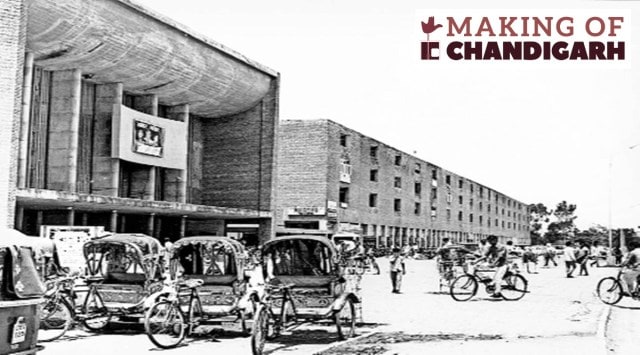Making of Chandigarh: What went into the robust heart of City Beautiful
Le Corbusier delineated the location of the city centre at the junction of two important arteries.
 Historic photograph of city centre showing V-4 street in front of Neelam Cinema. (Chandigarh College of Architecture)
Historic photograph of city centre showing V-4 street in front of Neelam Cinema. (Chandigarh College of Architecture)Written by Vipendra Singh Thakur and Vidhi Prakash
Chandigarh, the City Beautiful, where the radiance of nature and built environment is always within reach of its residents, was envisioned on a human scale by its planner, Le Corbusier. He planned the city analogous to the human body where the city centre represents the heart. Around 65 years back, the location of Chandigarh city was an agricultural land infused with mango groves. There were around 24 villages in between Sukhna and Patiala ki Rao rivulets. Sector 17, which is the heart of the city, filled with glitzy showrooms, was the location of the village Rurki Parao. Mathew Nowicki, a Polish architect, produced the city centre’s first plan, which included square and circular-shaped buildings separated from each other but connected with the network of walkways raised above the street level.
However, the plan was never executed as Mathew Nowicki was disengaged from the Chandigarh Project due to his untimely death in a plane crash.
Le Corbusier delineated the location of the city centre at the junction of two important arteries – the Madhya Marg (V2) and the Jan Path (V2), two major architectural axes of the city. Having a total area of around 240 acres, the city centre was divided into north and south zones. The main shopping plaza was designed with the idea of creating a “pedestrian paradise” taking inspiration from French plazas. The commercial centre was planned around the crossroad (chowk) to highlight the essence of traditional Indian chowk characteristics, with four-story-high buildings. Townhall, Central Library, regional headquarters of post and telegraphs, insurance offices and cinema halls were some iconic buildings designed around the chowk. Jagat and Neelam Theatre were reserved for entertainment where Neelam Cinema was positioned in the central axis with commercial shops on either side to give it more prominence. As per the mandate given to Le Corbusier, a major part of the city centre was assumed to be developed by the private enterprise; hence the original plans of the commercial plots were bigger than the actual plans. Since they could not be sold to private owners, Le Corbusier later reduced the designs to smaller shops.
The V4 (shopping street) that meandered and bisected each sector also ran through Sector 17, dividing it into two parts; where the south division was developed as a centre of district administration and the north division was reserved for the commercial, business, civic, and entertainment areas of the city. Historic photographs of rickshaws, bicycles, two-wheelers and buses flying along the V4 in front of the Neelam Cinema are a thing of the past today as the V4 was converted into a plaza with parking lots on either side to create an uninterrupted pedestrian paradise linking the Neelam Cinema to the bank square. The vehicular V4 street assumed its present location at the rear side of Neelam Cinema.
Prior to the development of the city centre, while the rest of Chandigarh was under construction, Sector 22 served as the model sector. Connaught Place in Delhi was the immediate precedent CBD from past in India, having concentric three-story buildings with 12-foot-wide veranda. Chandigarh’s city centre followed a similar scheme of providing a 12-foot-wide veranda.
Architect Maxwell Fry, one of the team members of the Chandigarh project, criticised the city centre as “devoid of street-level activities and treeless.” The width of pedestrian axes in the city centre plaza is so wide that it loses the capacity of shelter and enclosure when compared to the height of four-storey buildings around it. Compared to Connaught Place in Delhi, where one walks in concentric verandas with filtered vista, creating an element of surprise, the city centre of Chandigarh fails to provide such an exciting experience to the users.
In 2003, the Chandigarh administration had revised the policies regarding the land-use conversion and usage of buildings; Jagat Cinema is now converted into TDI mall having multiplexes in it and remains almost empty even during weekends. The fate of whether Neelam Cinema is to be converted into a multiplex is still undecided. It now exists as a stark landmark, which was once the most crowded place to watch a movie. The shift of ISBT from sector 17 to 43 has also affected the city centre as the buses used to bring the shoppers from outside into sector 17 too. Now buses are bringing the users to the city till sector 43; which is causing another split of the commute till sector 17.
The new land-use policy led to many malls coming up in the peripheral industrial areas of the city. These peripheral malls have stolen the enticement of the heart of Chandigarh. The mall culture is completely different from the Public Plaza, as a Plaza allows you quality time while walking between the city landmarks without paying for the space. The city’s heart is the place to see and be seen, a democratic place where anyone and everyone in the city can have an equal share of space and joy.
Central Business District of Sector 17 needs our attention and probably needs to be resuscitated as the heart of the city by pumping activities according to the city’s present needs contemporaneous to the change and demand.
(Making of Chandigarh part of the series of fortnightly articles by students and faculty of CCA on the Making of Chandigarh for the LCPJ forum. Ar Vipendra Singh Thakur is an Assistant Professor, Chandigarh College of Architecture and Vidhi Prakash is a Second Year M.Arch student.)












